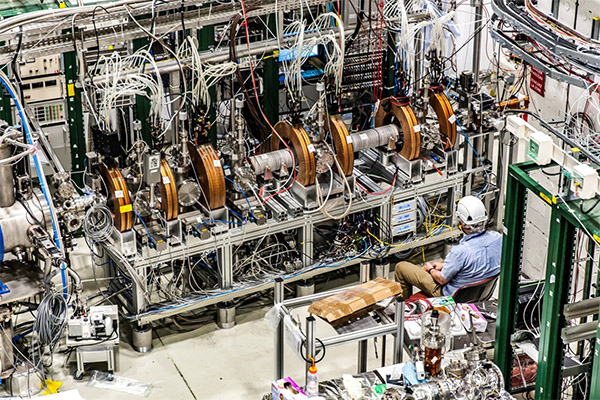GBAR joins the anticlub

The GBAR experiment at CERN has just joined the very select club of experiments that have succeeded in synthesising antihydrogen atoms.
The aim of the GBAR experiment at CERN is to measure the acceleration of an antihydrogen atom – the simplest form of atomic antimatter – in Earth's gravitational field, and to compare it with that of the normal hydrogen atom. Such a comparison is a crucial test of Einstein's equivalence principle, which states that the trajectory of a particle is independent of its composition and internal structure when it is only subject to gravitational forces.
However, producing and slowing down an antiatom enough to see it in free fall is no mean feat. GBAR's approach is to first produce an antihydrogen atom and then turn it into a positive ion (the antimatter equivalent of an H- ion). The ion can then be slowed down using quantum-optical techniques. Finally, the ion is neutralised for free-fall measurement. In a new paper, the GBAR collaboration reports the successful production of its first antiatoms.
To achieve this, the team has developed a complex protocol in which antihydrogen atoms are assembled from antiprotons produced by the Antiproton Decelerator (AD) and positrons produced in GBAR. The AD's 5.3-MeV antiprotons are decelerated and cooled in the ELENA ring and a packet of a few million 100-keV antiprotons is sent to GBAR every two minutes. In GBAR, a device called a pulsed drift tube further decelerates this packet to an adjustable energy of a few keV. In parallel, in another part of GBAR, a linear particle accelerator sends 9-MeV electrons onto a tungsten target, producing positrons, which are accumulated in a series of electromagnetic traps. Just before the antiproton packet arrives, the positrons are sent to a layer of nanoporous silica, from which about one in five positrons emerges as a positronium atom (the bound state of a positron and an electron). When the antiproton packet crosses the resulting cloud of positronium atoms, a charge exchange can take place, with the positronium giving up its positron to the antiproton, forming antihydrogen.
At the end of 2022, during an operation that lasted several days, the GBAR collaboration detected some 20 antihydrogen atoms produced in this way, validating this "in-flight" production method for the first time.
After this essential first step, the collaboration will now improve the production of antihydrogen atoms. This will enable precision measurements to be made on the antihydrogens themselves, in particular a measurement of an energy gap between two specific atomic levels, known as the Lamb shift. This measurement will give a more precise value of the radius of the antiproton. This will be followed by the production of positive antihydrogen ions, and finally by the implementation of the laser systems for cooling and neutralising these ions in order to finally observe the free fall of an antihydrogen atom.
GBAR is not alone in its aim of testing Einstein’s equivalence principle with atomic antimatter. ALPHA and AEgIS (which includes AVA partners the University of Liverpool and INFN) are also working towards this goal using other approaches. ALPHA, a pioneer in the synthesis and trapping of neutral antihydrogen, is the most advanced. The AEgIS experiment produces antihydrogen using the same reaction as GBAR with positronium. It detects the downward trajectory of antiatoms using a sensitive interferometer.
This article is based on an article on the CERN website which can be found here and an original article (in French) on the CNRS website here